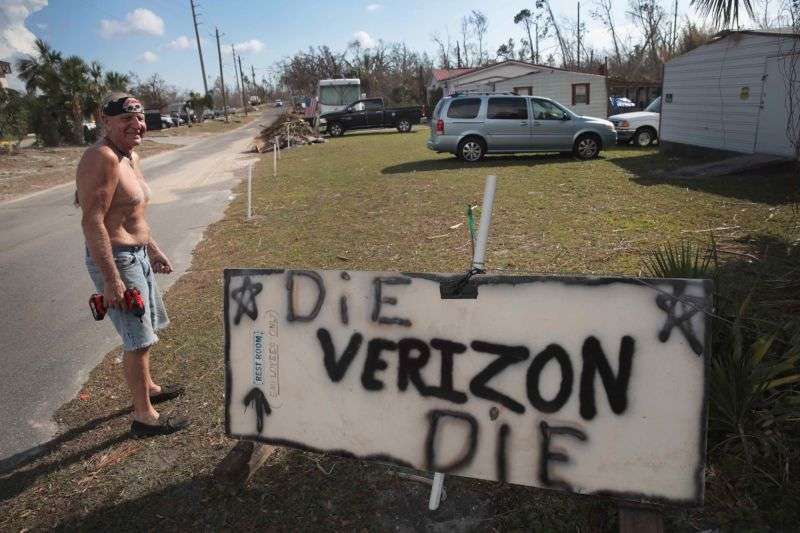
12 days after hurricane, Verizon says Florida network is back to normal

Verizon Wireless service is back up and running “essentially everywhere” throughout the area hit by Hurricane Michael, the company said today.
“Verizon engineers and fiber crews have been working around the clock after unprecedented damage to our fiber infrastructure caused by the most intense storm in history to make landfall in the Panhandle,” Verizon’s announcement said. “Services for our customers and first responders are back up and running today, providing wireless coverage essentially everywhere it was before Hurricane Michael hit.”
Verizon had faced repeated criticism from Florida Governor Rick Scott, who said Verizon lagged behind AT&T and other carriers in restoring service after the Category 4 hurricane made landfall on October 10. Scott last week suggested that Verizon misled the public about its post-hurricane recovery, saying that Verizon’s claim of covering “98 percent of Florida” was only accurate because it included customers “hundreds of miles away from impacted areas.”
But now, Verizon says its network is really almost back to full strength. When contacted by Ars today, Verizon said that only three cell sites are still out of service.
“One of those [three] sites has overlapping coverage serving the customers that would typically use that site, and one is in a very rural area,” Verizon told Ars. “Our teams continue to work on those and expect to have those up quickly.”
Verizon declined to say how many sites were previously out of service due to the storm, but the company said that having just three sites out now “translates into essentially the same customer experience as before the storm.” More post-hurricane updates from Verizon are available here.
Progress on speed and reliability
We asked Verizon if its current service has the same reliability and speed as it had before the hurricane. Verizon told us that it has made progress on both reliability and speed but that people might notice slowdowns partly because of demand on the network.
Here’s what Verizon told us about current data-speed levels:
As for speed, as is typical, that is really dependent on traffic and usage. There are some areas with more people than are normally there (consider first responders at EOCs [Emergency Operations Centers] set up in temporary locations), and as you know, when traffic is heavy, speeds can slow. Additionally, as many people are still without their home or business Internet connections, they are relying on our wireless network to do additional tasks, leading to greater data flowing over our network. We are monitoring traffic and adding capacity where necessary. We have also deployed dozens of portable cells to help offload the extra traffic.
Wireless-network reliability depends heavily on fiber lines, which suffered heavy damage. But Verizon told Ars today that it now has “a high degree of reliability back into the network.”
“We have been able to restore diversity into our fiber network, which is an important part of our reliability. With multiple paths now stable on each fiber ring, a single fiber cut will not result in a service interruption,” Verizon said.
Some Verizon facilities are still using generators “where commercial power has not yet been restored,” and those generators “are being refueled regularly,” Verizon said. At other cell sites, generators and batteries are on hand “in case we experience new power outages,” Verizon said.
Verizon’s network update urged people to avoid cutting fiber lines. The Verizon announcement said:
Nicki Palmer, Verizon’s chief network engineering officer and head of wireless networks, asked residents and rebuilders to help in the recovery effort by steering clear from fiber optic cables. “Simply stated: please don’t cut any cables you may see. Those cables may be live utility or telecommunications fiber cables. We are coordinating with power companies, state and local response teams, and local authorities with the goal of significantly reducing fiber cuts. That reduction will speed our ability to stabilize the wireless services already restored and accelerate progress across the Panhandle,” she said.
Verizon’s announcement also said that its “[r]ecovery teams remain throughout Panama City in remote command centers, and we will continue providing portable cell sites for additional coverage and capacity as they continue their important work.”
On Friday, AT&T said its network was “operating at more than 99.9 percent of normal [capacity].” T-Mobile said yesterday that “service in Bay and Gulf counties has been largely restored or has temporary solutions in place until permanent repairs are made to power and fiber.” Sprint’s hurricane update page hasn’t provided a network update since Wednesday, when it said that “ongoing commercial power outages and delays in fiber backhaul restoration” meant that “some customers in the hardest-hit areas by the hurricane are still experiencing disruptions in service.”
30% of cell sites in Bay County still out
When contacted by Ars today, Governor Scott’s office declined to comment on Verizon’s statement that it has restored service throughout the Panhandle.
Federal Communications Commission statistics show that the overall recovery isn’t quite complete, though the FCC does not reveal specific numbers for each carrier. As of today at 11am ET, 5.2 percent of cell sites in the 21-county disaster area were out. Bay County is still the most affected, with 29.7 percent (103 out of 347) of cell sites out of service. In Gulf County, 26.1 percent (6 out of 23) cell sites were still out of service today.
Verizon says it is giving three free months of mobile service to customers in Bay and Gulf counties.
FCC Chairman Ajit Pai said last week that carriers’ slow restoration of service was “completely unacceptable” and that the FCC would open an investigation. Pai also faced criticism because he previously eliminated consumer protections designed to ensure network stability after disasters.
An announcement from the governor’s office yesterday said that “66.09 percent of cellular service coverage has been restored in Bay County. This does not include mobile cellular assets augmenting the network.”




